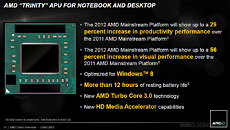Wednesday, April 4th 2012

Trinity Provides Up To 29% Faster Productivity, 56% Faster Visuals Than Llano: AMD
A marketing slide by AMD for industry partners, which sums up what the company's 2012 Mainstream Platform led by "Trinity" APUs will offer, got leaked to the web. In it, AMD claims its next-generation APUs to offer up to 29 percent higher productivity performance (read: CPU performance), and up to 56 percent higher visual performance, compared to current-generation (Llano). At least the graphics performance figures seem to be consistent with early test results.
Apart from these, the slide claims Trinity to be optimized for Windows 8 (with AVX, AES-NI, SSE4.2, and DirectX 11.1 graphics, it could very well be). The processor is said to feature third-generation auto-overclocking technology, TurboCore 3.0. The mobile version of the chip will be designed to offer over 12 hours of resting battery-life. Lastly, there's mention of new media-acceleration features. AMD is expected to launch its new line of APUs in this quarter (before July).
Source:
SweClockers
Apart from these, the slide claims Trinity to be optimized for Windows 8 (with AVX, AES-NI, SSE4.2, and DirectX 11.1 graphics, it could very well be). The processor is said to feature third-generation auto-overclocking technology, TurboCore 3.0. The mobile version of the chip will be designed to offer over 12 hours of resting battery-life. Lastly, there's mention of new media-acceleration features. AMD is expected to launch its new line of APUs in this quarter (before July).

148 Comments on Trinity Provides Up To 29% Faster Productivity, 56% Faster Visuals Than Llano: AMD
Well done AMD. Now give me my Vishera :)
on igp's side, it pretty good, 50% more than something that was already fast competing with intel, is good news.
trinity uses the same 32nm process as llano so getting these numbers in the same power envelope is pretty impressive.
however we do have to mention that llano was a step down in cpu performance than previous laptop cpus due to the lower clock speeds to meet the tdp when integrated with graphics
so overall amd will need this much increase per generation if they plan to catch up with intel or atleast close the gap a bit, so if amd can do 30% now and 30% next gen with the 28nm node they will pretty much become on par, tho that is very unlikely
Unless you're hoping for the IPC gains we're all hoping for. Well, everyone who wants AMD to survive for the long haul hopes for.
eg of rumour mill
www.engadget.com/2012/02/22/amd-piledriver-cores-will-employ-resonant-clock-mesh/
looking good in a realistic kind of way too:)
being realistic also means that in swapping from stars arch to piledriver arch they might have run into trouble since BD was a bit frequency happy, i am expecting some extreme Ocin results with these:D ,no comment on pciex allocation ever though, that to me could be the deal breaker , 1 or 2 pciex3 slots would be v nice
A CPU is not the same, it does not scale like that, but it still holds true to the iGPU. 56% over Llano is far from impressive IMO. Especially when we are talking about a marketing slide. Real difference is not going to be more than 20% on the GPU and 10% on the CPU most probably atributable to higher clocks.
and anyway since when was 56% imrpovement in 1 year bad intel are calling their next wave a tock+ because of a similar massive improvement , get real
and as ever your on the harsh side of negative and bringing the gtx680 in here tryin to wind some fanbois up , whats with you ,and bye:eek: